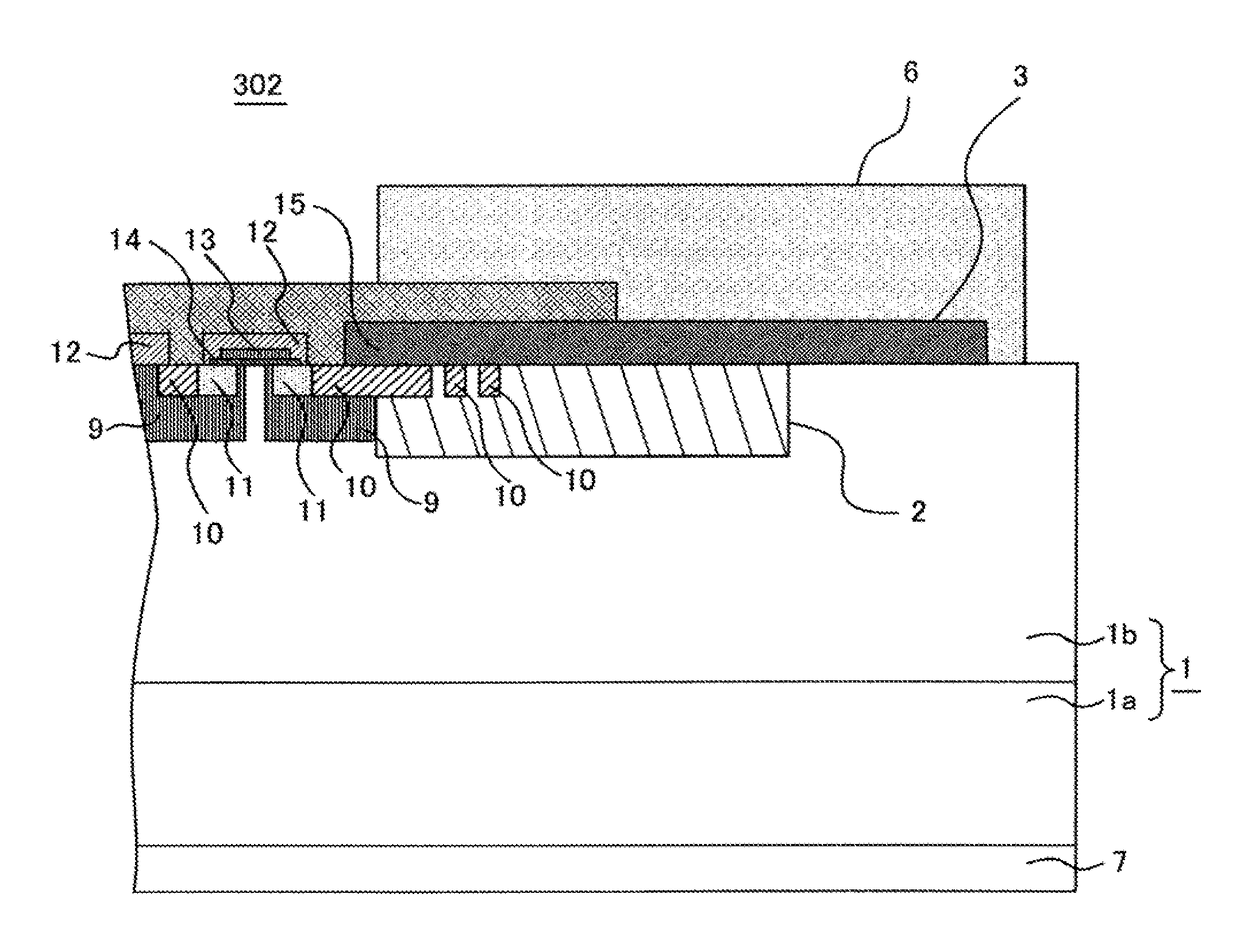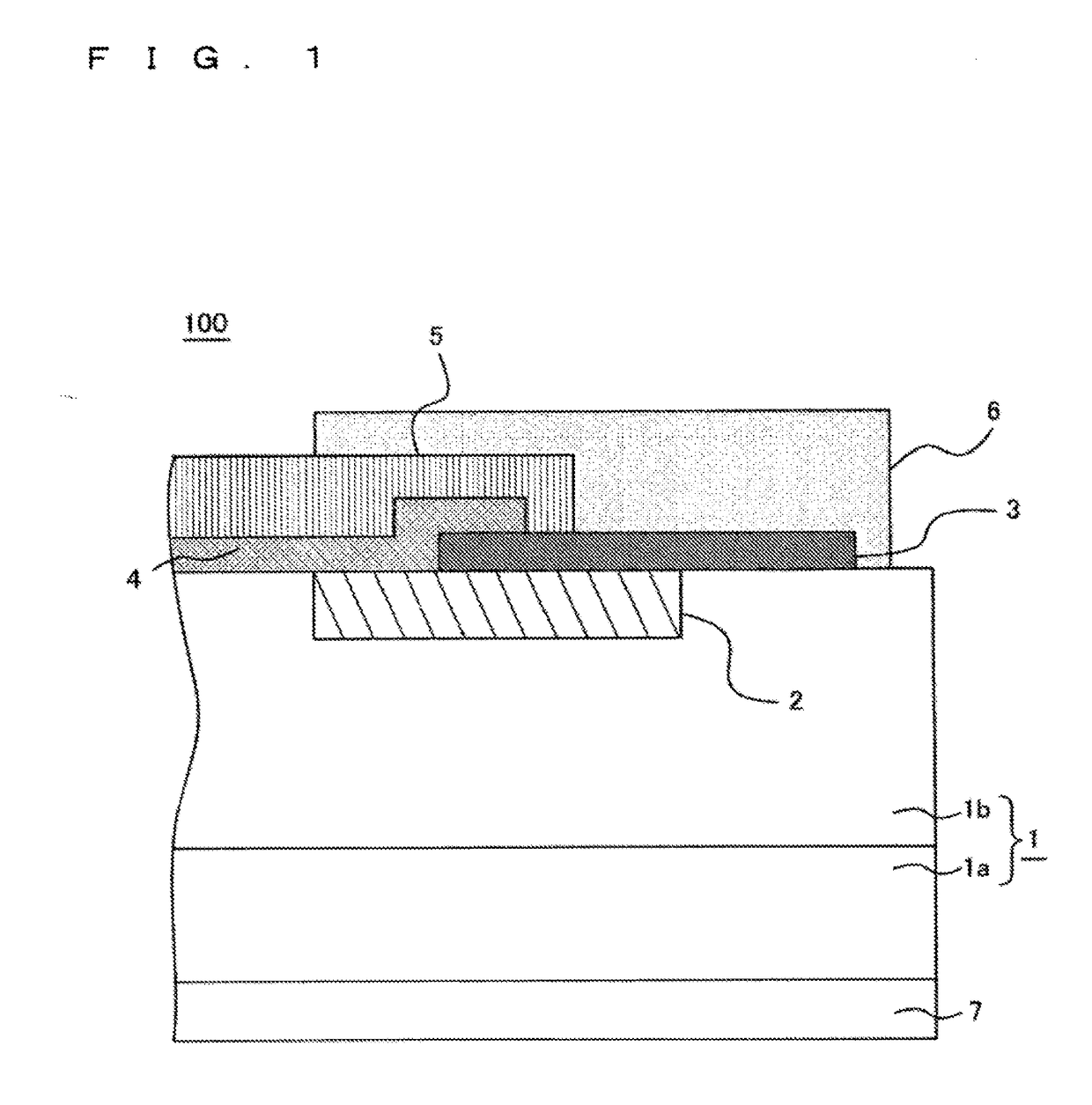Silicon carbide semiconductor device
a technology of silicon carbide and semiconductor devices, applied in the direction of semiconductor devices, basic electric elements, electrical apparatus, etc., can solve the problems of failure of silicon carbide semiconductor devices, and achieve the effect of reducing the density of equipotential
- Summary
- Abstract
- Description
- Claims
- Application Information
AI Technical Summary
Benefits of technology
Problems solved by technology
Method used
Image
Examples
embodiment 1
[0033]First, the configuration of a silicon carbide semiconductor device 100 in accordance with Embodiment 1 of the present invention will be described. Hereinafter, an N type SiC-SBD (Silicon Carbide Schottky Barrier Diode) in which the first conductivity-type is defined as the N type and the second conductivity-type is defined as the P type will be exemplified to be explained, but a P type silicon carbide semiconductor device in which the first conductivity-type is defined as the P type and the second conductivity-type is defined as the N type may be adopted and a PN diode or a PiN diode may be adopted instead of the SBD.
[0034]FIG. 1 is a sectional view showing the configuration of the silicon carbide semiconductor device 100 in accordance with Embodiment 1. In FIG. 1, only a cross sectional portion around the terminal end region of the silicon carbide semiconductor device 100 is illustrated, and in FIG. 1, the right side is the terminal end region side situated at the right end p...
embodiment 2
[0081]In Embodiment 1 described above, although electric field relaxation at the time of switching is attained by reducing the protruding width of the electrode pad 5, for the purpose of attaining further electric field relaxation, a high concentration terminal end well region where the P type impurity concentration is higher may be provided within a terminal end well region. On that account, as Embodiment 2, a silicon carbide semiconductor device provided with a high concentration terminal end well region will be described below.
[0082]FIG. 9 is a sectional view showing a silicon carbide semiconductor device 200 in accordance with the present embodiment. Since the silicon carbide semiconductor device 200 is different from the silicon carbide semiconductor device 100 in accordance with Embodiment 1 in the point that a high concentration terminal end well region 8 is provided thereto, hereinafter, only the high concentration terminal end well region 8 will be described, and the descri...
embodiment 3
[0095]In Embodiments 1 and 2 described above, although examples of the SiC-SBD which is a diode element are described, the present invention may be applied to a switching element. On that account, as Embodiment 3, the case where the present invention is applied to an MOSFET (Metal Oxide Semiconductor Field Effect Transistor) which is a switching element will be described.
[0096]FIG. 15 and FIG. 16 are sectional views showing a silicon carbide semiconductor device 300 in accordance with the present embodiment. FIG. 15 is a sectional view of a region where a source electrode 15 described below extends up to the terminal end region side, and FIG. 16 is a sectional view of a region where a gate electrode 13 described below extends up to the terminal end region side to connect to a gate pad 16. That is, FIG. 15 is a sectional view of a region where the source electrode 15 extends to the outermost peripheral side, and FIG. 16 is a sectional view of a region where the gate electrode 13 exte...
PUM
| Property | Measurement | Unit |
|---|---|---|
| distance | aaaaa | aaaaa |
| thickness | aaaaa | aaaaa |
| distance | aaaaa | aaaaa |
Abstract
Description
Claims
Application Information
 Login to View More
Login to View More - R&D
- Intellectual Property
- Life Sciences
- Materials
- Tech Scout
- Unparalleled Data Quality
- Higher Quality Content
- 60% Fewer Hallucinations
Browse by: Latest US Patents, China's latest patents, Technical Efficacy Thesaurus, Application Domain, Technology Topic, Popular Technical Reports.
© 2025 PatSnap. All rights reserved.Legal|Privacy policy|Modern Slavery Act Transparency Statement|Sitemap|About US| Contact US: help@patsnap.com



